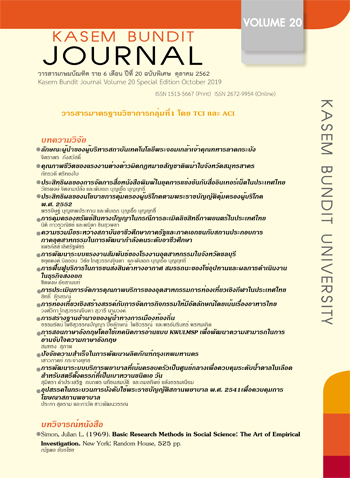Development of Family-Centered Nursing Service System for Glycemic Control in Pregnant Women with Gestational Diabetes Mellitus Class A1
Keywords:
Gestational diabetes mellitus, family-centered, glycemic control, nursing service system, pregnant womenAbstract
The main purpose of this action research was to develop the family-centered nursing service system for glycemic control in pregnant women with gestational diabetes mellitus class A1 (GDM A1). The main informants were 39 pregnant women with GDM A1, 39 family members, and 9 minor informants who were multidisciplinary team members. It was found that the family centered-nursing service system consisted of the following: assessing risk factors for diabetes in pregnant women who received the first antenatal care; advices to the pregnant women with GDM A1 and their families as detailed in the manuals and medical records for reviewing at their homes; blood glucose levels monitoring for the pregnant women with GDM A1 by FBS and 2hrPP tests every time they came to the examination appointment; monitoring system during childbirth and postnatal periods by visiting the mothers and infants at ward as well as data recording; and monitoring system during postpartum period for 6 weeks by 75g-OGTT. The satisfaction of pregnant women with GDM A1 and their families on the nursing service system was at a high level. The multidisciplinary teams were satisfied and proud with the improved nursing service system.
References
Carolan-Olah, M. C. (2016). Educational and intervention programmes for gestational diabetes mellitus (GDM) management: An integrative review. Collegian, 23(1),103-114.
Chirapat, W. (2557). Family-centered strategy For sustainable quality of perinatal care.In P. Sukosri, N. Wongpaitoon, P.Phadungkietwattana, and N.Srisanthiroj (Ed.),Quality perinatal care. Bangkok: Union Creation
Dornhorst,A.,& Frost,G. (2009). International Diabetes Federation.(Online).Available: https://www.idf.org/sites/default/files/FULL-STUDY_0.pdf
Garnweidner, L. M., Sverre, P. K., & Mosdøl, A. (2013). Experiences with nutrition-related information duringantenatalcareofpregnant women of different ethnicbackgrounds residing in the area of Oslo, Norway. Midwifery, 29(12), e130-e137.
Mitanchez, D., Burguet, A., & Simeoni, U. (2014). Infants born to mothers with gestational diabetes mellitus: Mild neonatal effects, a long-term threat to global health. The Journal of Pediatrics, 164(3),445-450.
Prasertcharoensuk, V.(2007). Medicalcomplications in elderly gravida. Srinagarind Medical Journal, 22(suppl.)39-42
Saensiriphan, N. (2555). Nursing care for women with Medical complications. In N. Saensiriphan, and C .Baoruang (Ed.), Nursing and Midwifery, Volume 3, Women with complications. Chiang Mai: Dominate printing technicians.
Schneider,S., Freerksen, N., Rohrig,S., Hoeft, B., &Maul, H. (2012). Gestationaldiabetesand preeclampsia--Similar riskfactorprofiles?. Early Human Development, 88(3),179-184.
Tam, W. H., et al. (2012). Cardiometabolic risk in Chinese women with prior gestational diabetes: A 15-year follow-up study. Gynecologic and Obstetric Investigation, 73(2), 168-176.
Thongsong, T. (2555). [Obstetrics and Gynecology. (5th ed.)]. Department of Obstetrics and Gynecology Faculty of Medicine Chiang Mai University. Bangkok: Lakshmi Rung Company Limited.
Downloads
Published
How to Cite
Issue
Section
License
ทัศนคติ ความคิดเห็นใด ๆ ที่ปรากฏในวารสารเกษมบัณฑิตฉบับนี้เป็นของผู้เขียน โดยเฉพาะ มหาวิทยาลัยเกษมบัณฑิตและบรรณาธิการ ไม่จำเป็นต้องมีความเห็นพ้องด้วย







